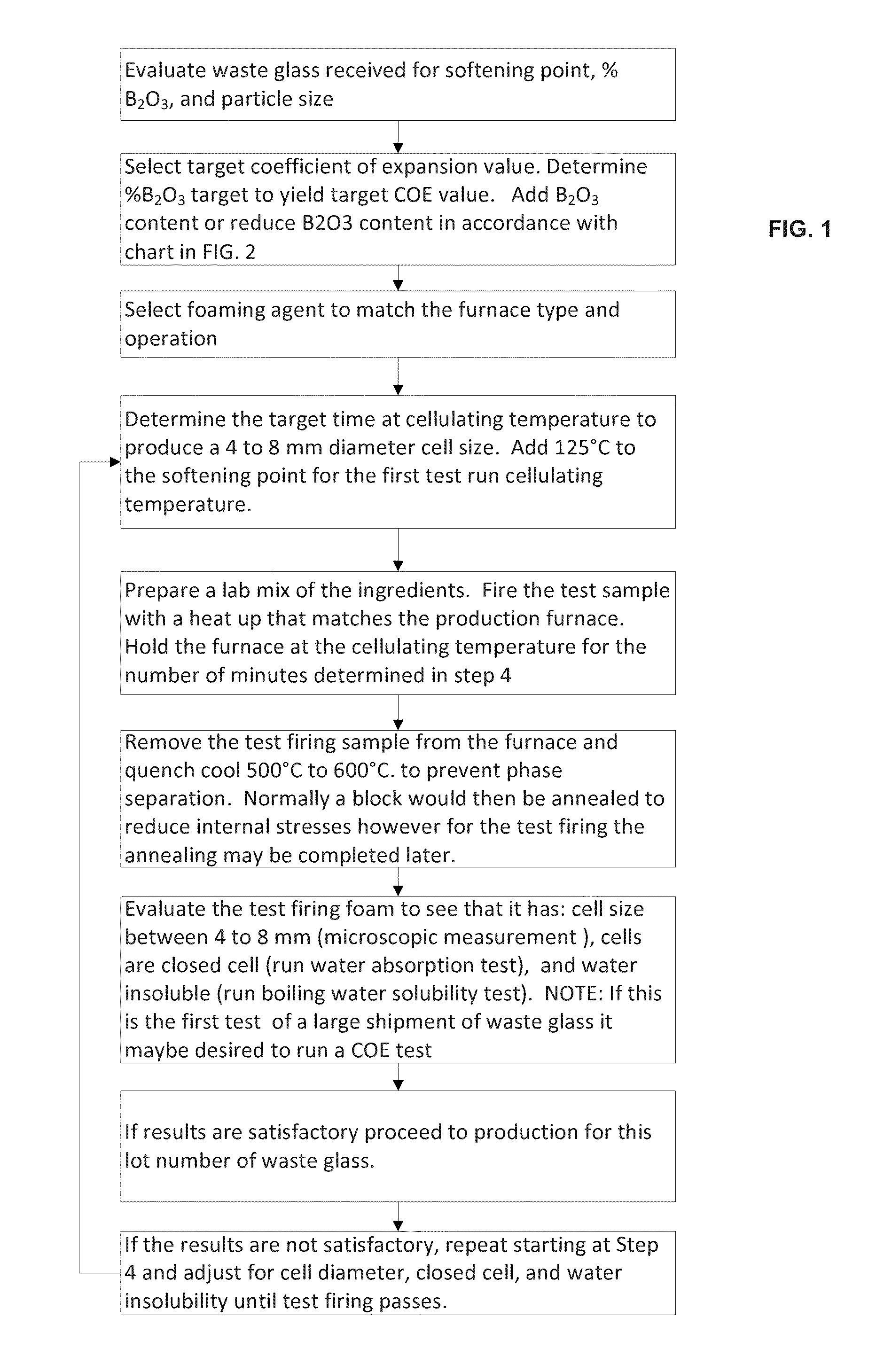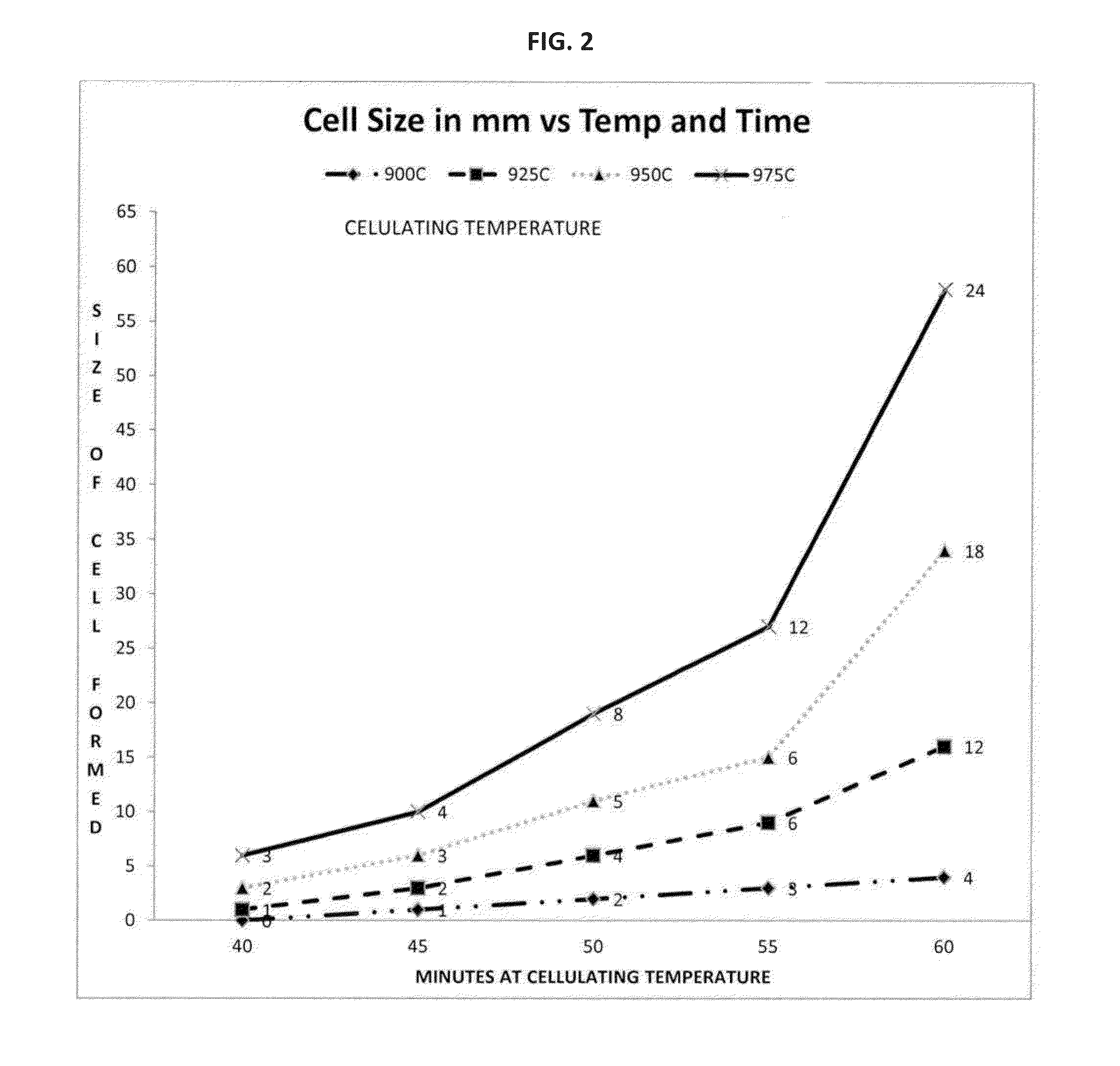Method for producing cellular glass from waste glass streams
a technology of glass streams and cellular foam, which is applied in the field of cellular foam glass blocks, can solve the problems of water soluble foam that is unsuitable, structural damage to the flue gas stack, and water soluble foam of foamed glass, and achieves good water and chemical resistance and low density
- Summary
- Abstract
- Description
- Claims
- Application Information
AI Technical Summary
Benefits of technology
Problems solved by technology
Method used
Image
Examples
case a-1
[0039] Add antimony trioxide (Sb2O3) from 0.2% to 1.5% by weight of batch mixture. Add Carbon from 0.2% to 1% by weight of batch mixture. Mix with waste glass stream using standard mechanical equipment. The particle size of the mixture will determine the cell size in the foamed glass. Cellulate for time and temperature as determined by the Chart Typical Cellulating Curves in FIG. 2 representing values for a tunnel or fast heat up batch furnace. (Waste Borosilicate Glass 200 (13% B2O3), antimony trioxide 0.2%, carbon 0.56%, glass melting point 832° C., glass particle size −200 mesh, Heat up 50° C. / minute, Cellulating time 45 minutes Temp 975° C.). (Immediately quench to 750° C.). Results excellent closed cell foam and glass structure having a density of 11.5 lbs / ft3 with excellent chemical resistance and a coefficient of expansion within target range (measured at 33×10−7 COE).
case a-2
[0040] Add Calcium Carbonate (CaCO3) from 0.2% to 5% by weight of batch mixture. Mix with waste glass stream using standard mechanical equipment. Particle size of the mixture will determine the cell size in the foamed glass. Cellulate for time and temperature as determined by the Chart Typical Cellulating Curves in FIG. 2 representing values for a tunnel or fast heat up batch furnace. (Waste Borosilicate Glass 300 (11% B2O3, antimony trioxide 0.2%, calcium carbonate 1.56%, glass melting point 800° C., glass particle size −230 mesh, Heat up 50° C. / minute, Cellulating time 45 minutes, temperature 945° C.) (immediately quench to 750° C.). Results: gas released before glass mix reached foaming viscosity. No foam, solid glass block.
case a-3
[0041] Add Calcium Sulfate (CaSO4) from 0.2% to 5% by weight of batch mixture. Particle size of the mixture will determine the cell size of the foamed glass. This material is available in large quantities from a waste stream. Mix with waste glass stream using standard mechanical equipment. Cellulate for time and temperature as determined by the Chart Typical Cellulating Curves in FIG. 2 representing values for a tunnel or fast heat up batch furnace. (Waste Borosilicate Glass 320 (7.0% B2O3), antimony trioxide 0.2%, calcium sulfate 1.0%, glass melting point 832° C., glass particle size −230 mesh, Heat up 50° C. / minute, Cellulating time 45 minutes temperature 945° C.) (Immediately quench to 750° C.). Results in excellent closed cell foam and glass structure having a density of 11.0 lbs / ft3. Excellent chemical resistance and coefficient of expansion within target range. (measured 55×10−7 COE).
PUM
| Property | Measurement | Unit |
|---|---|---|
| temperature | aaaaa | aaaaa |
| temperature | aaaaa | aaaaa |
| density | aaaaa | aaaaa |
Abstract
Description
Claims
Application Information
 Login to View More
Login to View More - R&D
- Intellectual Property
- Life Sciences
- Materials
- Tech Scout
- Unparalleled Data Quality
- Higher Quality Content
- 60% Fewer Hallucinations
Browse by: Latest US Patents, China's latest patents, Technical Efficacy Thesaurus, Application Domain, Technology Topic, Popular Technical Reports.
© 2025 PatSnap. All rights reserved.Legal|Privacy policy|Modern Slavery Act Transparency Statement|Sitemap|About US| Contact US: help@patsnap.com



